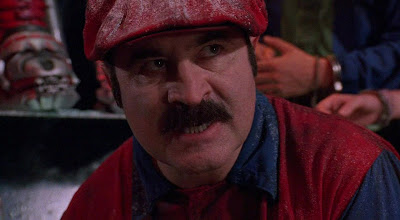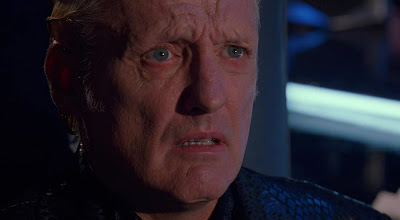For the longest time, most live-action video game movies haven’t been of the best quality, though the first of them, the infamous 1993 Super Mario Bros. film, didn’t really set a good precedent, mainly due to how little it resembles the source material. While more recent efforts have been getting better, it can be interesting to look back on this film to see what went wrong, and with the release of the more faithful animated film, now is as good a time as any. While I had been wanting to re-review this film anyway since I was not completely satisfied with my first attempt, it has become much harder to do so, at least if you live in the US, since it cannot be streamed anywhere and the more recent Blu-ray release has become more difficult to come by. Fortunately, it is still possible to get a cheap DVD copy, which allowed me to watch the movie again with fresher eyes after having not seen it in over a decade. Unfortunately, it’s still not that great of a movie even on its own merits, although it’s easier to see why it has attracted a cult following in the 30 years since its release.
Mario Mario (Bob Hoskins) and Luigi Mario (John Leguizamo) are Brooklyn plumbers looking for a job, but when they finally get one, they are beaten to the punch by rival Anthony Scapelli’s company. At the same time, Daisy (Samantha Mathis) has been fighting Scapelli to go through with an archaeological dig, meanwhile she has been followed by Iggy (Fisher Stevens) and Spike (Richard Edson), who have been looking for a girl by order of the mysterious Koopa. After Luigi meets Daisy and they have dinner together, they find Scapelli’s company trying to flood a tunnel to prevent the dig from going through, and manage to fix the pipe with the help of Mario. Shortly after, Iggy and Spike kidnap Daisy, leading Mario and Luigi to make chase and follow them into a portal to another world hidden behind the rocks.
 |
| Luigi (John Leguizamo, left) and Mario (Bob Hoskins, right) are beaten to a job. |
Interestingly, the movie seems to follow some similar story beats to its later animated counterpart, such as Mario and Luigi being plumbers who are transported to another world while fixing an underground pipe, as well as a final battle that involves going back into the original world. That said, these plot points are executed far differently, and while it does follow Mario’s original backstory at the time, there is otherwise little resemblance between the film and the game. Granted, there wasn’t much to go on at the time unlike the animated film, but it can still feel like a ‘90s dark fantasy film with Mario elements slapped on. It is possible to try and view the movie while trying not to think about its source material, but in that case it’s not that great on its own merits and in either case it drags a bit in the middle. That said, the opening sequence in Brooklyn is actually pretty entertaining and Mario and Luigi’s believable dynamic helps to keep things somewhat interesting, though it can only help so much. One thing the movie does deserve credit for, however, is using the character of Daisy rather than the more well-known and expected Peach, which helps it stand out from other Super Mario Bros. media, even today.
While the scenes set in Brooklyn feel true to life, perhaps the most glaring difference from the source material is that the Mushroom Kingdom looks nothing like the game, instead appearing like something out of Blade Runner. For what its worth, with the set design being one of the few things I actually liked about Blade Runner, the Mushroom Kingdom’s appearance is truly unique, perfectly capturing the essence of a dystopian society with a lot of clever nods to the source material, with the Thwomp Stomper boots in particular being a rather creative way to incorporate the games’ signature jumping mechanics. That said, several characters from the games have appearances that, while original, aren’t very accurate to the game at all, with Toad and Koopa (aka Bowser) being among the more glaring standouts, and the Mario brothers aren’t seen wearing anything even remotely resembling their iconic outfits until the third act. Not all is lost, however as the Thwomp Stompers’ Bullet Bill cartridges (which more closely resemble Banzai Bills) and the Bob-omb (save for its Reebok shoes) are surprisingly game-accurate for what they are, and while Yoshi’s silver screen debut isn’t exactly game-accurate either, they were still able to work in the mechanic of his long stretchy tongue.
 |
| Most characters don't resemble their game counterparts, Yoshi included. |
One of the stronger aspects of the film would be its casting choices, which make evident that the actors did the absolute best they could with a bad script. In particular, Bob Hoskins and John Leguizamo present the relationship between Mario and Luigi in a way that’s believable and the late Dennis Hopper, for what it’s worth, does a great job in the role of Koopa. The music is also good and feels consistent with Alan Silvestri’s other work, however those looking for something more in line with the games will be disappointed by the fact that it only sounds like that for the first 20 seconds. The licensed tracks are an interesting mix to say the least, being probably the only time you will ever hear a Megadeth track (“Breakpoint”) in an official Mario project of any sort, though the use of Was (Not Was)’s “Walk the Dinosaur” feels a bit on-the-nose given the setting.
 |
| For what it's worth, Dennis Hopper still has a strong performance as Koopa. |
Whatever problems this film has can be traced back to its very troubled production. For starters, the actors had all signed on for a script that was more in line with the games, in which Mario and Luigi try to stop Koopa from marrying Princess Daisy to get the Crown of Invincibility (incidentally, this plot sounds very similar to what would become the plot of the animated film 30 years later). Then-husband-and-wife team Rocky Morton and Annabel Jankel of Max Headroom fame were later attached to direct, however they immediately took the film in a far different direction, which no one else on the production liked, leading the production to go on for a lot longer than anticipated and for it to go way over budget, with Bob Hoskins and John Leguizamo notably turning to alcohol to get through the shoot. While John Leguizamo and Samantha Mathis have looked back on the film more fondly in hindsight, Bob Hoskins and Dennis Hopper did not, citing it as one of the worst decisions they had ever made in their careers.
As mentioned previously, the movie has attained a cult following over the years, so much so that there is a fan site dedicated to the film known as Super Mario Bros. The Movie Archive (aka SMBArchive) that meticulously catalogues every aspect of its production and related media, as well as featuring exclusive interviews with cast and crew members. While a sequel to the movie was not produced, even though one was seemingly teased at the end, an unofficial sequel was produced in the form of a webcomic, written by SMBArchive editors Steven Applebaum and Ryan Hoss in collaboration with screenwriter Parker Bennett (whose main contribution was providing broad strokes ideas of what he would have done with a sequel film). The comic began in 2013 and abruptly stopped updating in 2015, leaving the comic in an unfinished state as of 2023, but those that are curious to read it can find it at smbthecomic.com.
While one of the more infamous examples of a video game movie, it cannot be denied that the 1993 Super Mario Bros. film has had a cultural impact that is evident to this day, with its cult status and historical significance being the main reasons to watch it once in spite of its quality. Otherwise, for those looking for a more faithful take on the games, watch the animated film instead.




No comments:
Post a Comment